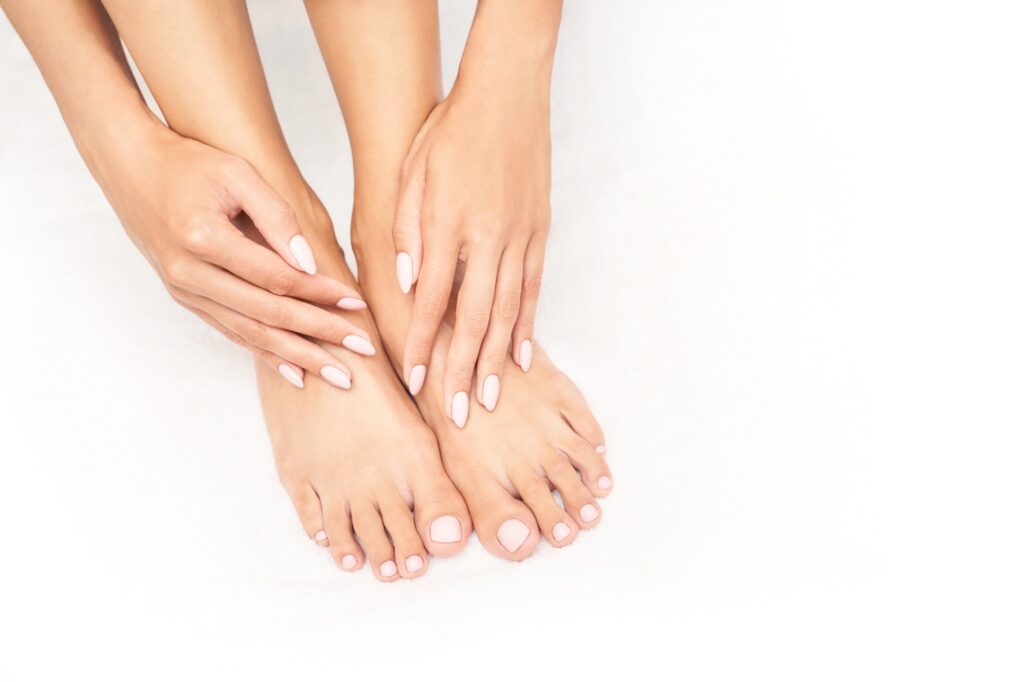Feel confident in your flip flops again.
No problem, we specialize in advanced and effective treatments to help you regain confidence and enjoy healthier, fungus-free nails. Our expert team is committed to providing personalized solutions tailored to your unique needs to clear up your toe nail fungus so you can put your flip flops on with confidence.

What to expect during toe fungus treatment
Consultation: Begin your journey to healthier nails with a comprehensive consultation. Our experienced healthcare professionals will assess your condition, discuss your medical history, and create a customized treatment plan based on your specific needs.
Laser Therapy: Our state-of-the-art laser therapy can provide targeted relief. Laser light penetrates the nail bed, effectively eradicating the fungus without harming the surrounding tissues. This treatment is quick, virtually painless, and may require multiple sessions for optimal results.
Topical Treatments: Depending on the severity of the infection, topical antifungal medications may be recommended. These medications are applied directly to the affected nails to target the fungus and promote healthy nail growth.
Oral Medications: In some cases, oral antifungal medications may be prescribed to address the infection from within. These medications are effective for treating stubborn or severe toenail fungus.
Follow-Up Care: Regular follow-up appointments allow us to monitor your progress, adjust the treatment plan if necessary, and provide guidance on maintaining good foot hygiene to prevent recurrence.
Key characteristics of toenail fungus
Discoloration: The affected toenail may change color, often turning yellow, brown, or white. In some cases, the nail may become green or black.
Thickening: The infected nail often becomes thickened and may develop an irregular shape. As the fungus progresses, the nail may become brittle and prone to crumbling.
Distorted Shape: The shape of the nail may change, and it may lift away from the nail bed. This can create a gap where debris and additional fungi can accumulate.
Texture Changes: The texture of the nail may become rough or pitted, and there may be visible debris or crumbling at the edges.
Foul Odor: In advanced cases, toenail fungus may produce a foul odor.
Toe Nail Fungus Pre-Care Instructions
Proper pre-care is essential to ensure the success of toenail fungus treatment. Here are pre-care instructions to help you prepare for your treatment:
Consultation: Schedule and attend a comprehensive consultation with our healthcare professional. Be prepared to discuss your medical history, any existing health conditions, medications you’re taking, and your expectations from the treatment.
Keep Nails Clean: Thoroughly clean your toenails before the treatment day. Wash your feet with mild soap, and use a soft brush to clean under and around the nails. Dry your feet thoroughly, paying extra attention to the spaces between the toes.
Remove Nail Polish: If you have nail polish or any other cosmetic products on your toenails, remove them before the treatment. Clean, polish-free nails ensure optimal contact and absorption of the prescribed medications or laser therapy.
Avoid Other Nail Treatments: Refrain from other nail treatments such as manicures or pedicures in the days leading up to your appointment. These treatments may interfere with the effectiveness of the toenail fungus treatment.
Wear Comfortable Shoes: Wear comfortable and breathable shoes on the day of your treatment. This minimizes any potential irritation or discomfort during and after the procedure.
Hydrate and Moisturize: Keep your feet hydrated by applying a moisturizing cream to the skin around your toenails. However, avoid applying any creams or lotions on the actual nails on the day of the treatment, as this can affect the absorption of medications.
Avoid Blood-Thinning Medications: If approved by your healthcare provider, consider avoiding blood-thinning medications or supplements (such as aspirin or fish oil) for a few days before the treatment. This reduces the risk of bleeding during and after the procedure.
Bring Comfortable Clothing: Wear loose and comfortable clothing on the day of your treatment, especially if the toenail fungus affects your toes. This ensures ease of access for the healthcare professional.
Follow Fasting Instructions: If your treatment involves oral medications, follow any fasting instructions provided by your healthcare provider. This may involve refraining from food or drink for a specified period before the treatment.
Inform Your Provider: If you develop any signs of infection, such as redness, swelling, or drainage around the toenails, inform your healthcare provider before the scheduled treatment. They may need to assess the situation and decide on the best course of action.
Toe Nail Fungus Post-Care Instructions
Topical Medication: Apply an antifungal cream with one of the following active ingredients: clotrimazole 1%, tolnaftate 1%, terbinafine 1% or miconazole 2%, butenafine 1% to the skin on the bottom of your feet, sides of your feet, between your toes, and around your nails. (This cream is not intended for use on your nails.) Apply 2 times a day for 2 weeks; after 2 weeks, apply once a day indefinitely, or as instructed by your provider. This prescription can be picked up from Everwell pharmacy.
Footwear: Spray the insides of your shoes with an antifungal spray such as Lotrimin or Lamisil at the end of each day or use an ultraviolet shoe sterilizer (SteriShoe®) as directed. Try not to wear the same shoes every day.
Powders: If your feet sweat a lot, use an antifungal powder such as Tinactin or Lotrimin.
Clean Clippers: Buy new nail clippers and files since your current pair may be infected. Metal nail care instruments may also be cleaned with diluted bleach or boiling water.
Grooming: Keep your toenails trimmed and cleaned their instruments properly or use a whirlpool system.
Keep Feet Dry: Ensure that your feet stay dry and clean. Dry your feet thoroughly after bathing, and change into clean, dry socks regularly. Moisture can contribute to fungal growth, so maintaining dry conditions is essential.
Proper Nail Care: Trim your toenails straight across and keep them short. Avoid cutting the nails too close to the skin to prevent any potential injury. Use a clean and sterilized nail clipper.
Wear Breathable Shoes: Opt for shoes made of breathable materials, such as leather or canvas, to allow air circulation around the feet. Avoid tight or ill-fitting shoes, as they can create a conducive environment for fungus.
Follow Prescribed Medications: If your treatment involves topical or oral medications, strictly follow the prescribed regimen. Finish the entire course of medications, even if the symptoms have improved before completion.
Protect Your Nails: If your treatment includes a protective covering or dressing, keep it in place as instructed by your healthcare provider. This helps protect the treated nails and promotes optimal healing.
Maintain Good Foot Hygiene: Continue practicing good foot hygiene. Wash your feet daily with mild soap, and thoroughly dry them afterward. Pay special attention to the spaces between the toes.
Avoid Tight Footwear: Steer clear of tight or constrictive footwear that may cause discomfort or pressure on the treated toenails. Choose shoes that provide ample space for your toes.
Monitor for Signs of Infection: Keep an eye on the treated toenails for any signs of infection, such as increased redness, swelling, or discharge. If you notice any concerning symptoms, contact your healthcare provider promptly.
Patience for Results: Results may take time to manifest. Be patient and allow the nails to grow out and renew naturally. It may take several months for new, healthy nails to replace the affected ones.
Follow-Up Appointments: Attend any follow-up appointments scheduled by your healthcare provider. These appointments allow them to assess the healing progress, make any necessary adjustments to the treatment plan, and address any concerns you may have.
Preventive Measures: To prevent future fungal infections, practice ongoing preventive measures, such as maintaining good foot hygiene, wearing breathable shoes, and avoiding sharing personal items like nail clippers.
Frequently asked questions
Book Your Toe Fungus Treatment Today
Schedule a toe fungus consultation in Pensacola, FL and take the first step towards healthier, more beautiful nails. Your journey to fungus-free toes starts here.
